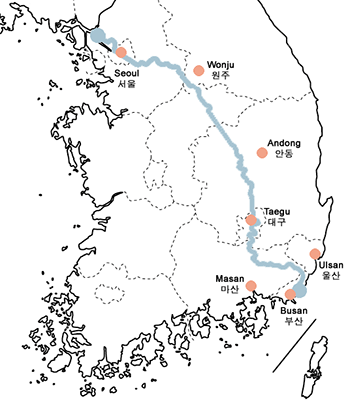The Grand Canal Proposal

Han and Nakdong Rivers.
Map originally created and © of the Korean NGOs Alliance.
As an organisation dedicated to the conservation of birds and their habitats in Korea and the wider Yellow Sea Eco-region, Birds Korea has already started to express our extremely serious concerns (to media, to other organisations and through our websites) about the proposed Korean Grand Canal scheme, as we believe, along with many others, that it will cause enormous impacts on both national and regional biodiversity.
If completed as proposed, the Grand Canal project will link up all four of South Korea's major river systems (the Yeongsan, Geum, Nakdong and Han), and even link rivers in the North with those of the South.
Easy to draw in an engineer's office, the Grand Canal in reality will require the dredging, deepening and widening of approximately two thousand kilometers of shallow river courses in South Korea (and apparently another thousand kilometers in DPRK). These shallow rivers are presently used by a broad range of bird species (from e.g. breeding Long-billed Plover Charadrius placidus and Mandarin Duck Aix galericulata, to roosting globally Vulnerable Hooded Cranes Grus monacha on southward migration, to large numbers of wintering waterbirds, including small numbers of the globally Endangered Scaly-sided Merganser Mergus squamatus.)
We believe that maintenance of 6m water depth as apparently proposed in these river-canals, especially in drought-prone Korea, will cause major changes in the hydrology of much of the whole river systems, impacting numerous relict freshwater wetlands, as well as one of Korea's most well-known Ramsar sites, Upo Wetland.
No doubt the Grand Canal system will also require further concreting and reinforcement of dykes along its length: with a total length projected at 3,100 km this will require a minimum 6,200 km of reinforced banks and roads, leading to further massive loss of riverine habitat.
The Grand Canal will also likely increase disturbance and pollution enormously along these same river lengths, as its proposed enduse will be for shipping of goods as well as people.
The Grand Canal system will also further cause significant impacts on (at least) three internationally important estuaries (as defined by Ramsar criteria):
The Han-Imjin Estuary (that supports up to 1500 Vulnerable Swan Goose Anser cygnoides on migration, and large numbers of Vulnerable White-naped Cranes Grus vipio);
The Geum Estuary (that supports large numbers of waterbirds, including just upstream of the estuary on occasion 90% of the world's Vulnerable Baikal Teal Anas formosa);
The Nakdong Estuary in Busan, already severely degraded but supporting wintering species such as Vulnerable Relict Gull Larus relictus and Korea's largest concentration of Whooper Swan Cygnus cygnus.
and
One of the canals will even run through the Saemangeum area, reducing further any opportunities there for mitigation of impacts on wildlife by that other massively-destructive project.
In total probably between 8 and 10 Important Bird Areas listed by BirdLife International (2004) will be significantly affected by the Grand Canal system, out of a national total of only 40 such sites so far identified.
It seems extraordinary in such a highly advanced nation like Korea, to have to even discuss the threats to biodiversity that a project like the Grand Canal might pose, and to state to sometimes sceptical proponents that construction of bicycle trails or small parks along the Canal's length will not somehow make the whole environmentally-friendly.
After all, we already have multiple conservation laws here in South Korea, and many of the species which will be significantly impacted by the Project are already protected by domestic law, and are designated as National Natural Monuments. As a nation, we are also a contracting party to both the Convention on Biological Diversity and to the Ramsar "Wise Use of Wetlands" Convention, even hosting the next triennial Ramsar Convention Conference, in Changwon City in October this year.
Can canalization of all of our nation's major rivers ever really be called "Wise Use", by anyone?
We will be posting more details and opinions on the anticipated impacts on birdlife of this massive scheme within the coming days and weeks, but for now we would like to inform especially our overseas membership and English-speaking visitors of two (urgent) online petitions:
The "Petition for Adherence to National Conservation Laws and Guidance Provided by the Ramsar Convention", requesting a much fuller assessment of the anticipated impacts of the Grand Canal project on biodiversity and wetlands, at:
Petition signatures will be shared with KFEM and submitted to government, along with a formal letter from Birds Korea (and we intend other bird conservation organisations), before the end of March.
The Petition "To Help Stop Great Korea Canal Project", urging the immediate cancellation of the Grand Canal scheme, organised by KFEM (the Korean Federation of Evironmental Movements and Korean office of Friends of the Earth) and hosted by Friends of the Earth International, at:
http://www.foei.org/en/get-involved/take-action/great-korea-canal-project/
Questions regarding this KFEM/FoEI petition should please be sent direct to:
Mr. Ma Yong-Un, at: ma@kfem.or.kr
and
With thanks,
Birds Korea, March 18, 2008.
Reference
- BirdLife International (2004). Important Birds Areas in Asia: key sites for conservation. Cambridge, Uk: BirdLife International (BirdLife Conservation Series No. 13).
Moores, N.
The Korean Grand Canal: another huge threat to the region’s wetlands and waterbirds
Birding Asia 10 2008: 48-53



